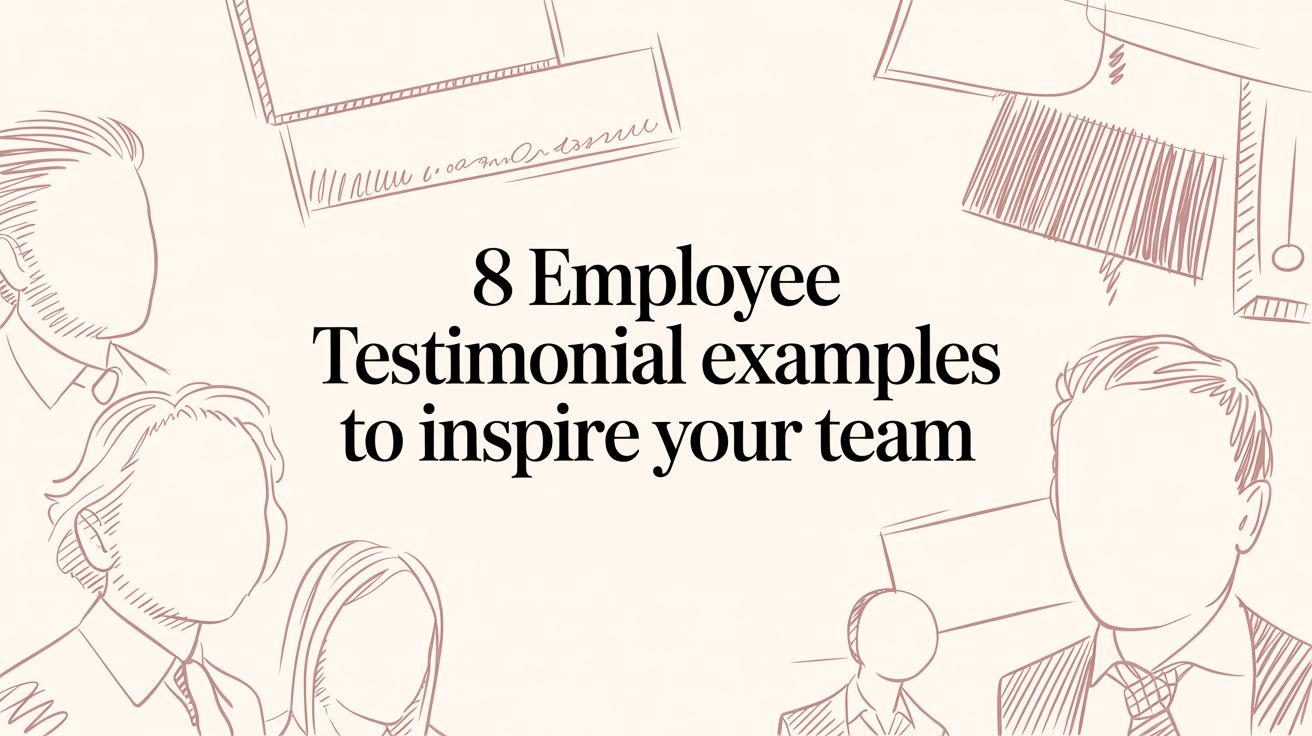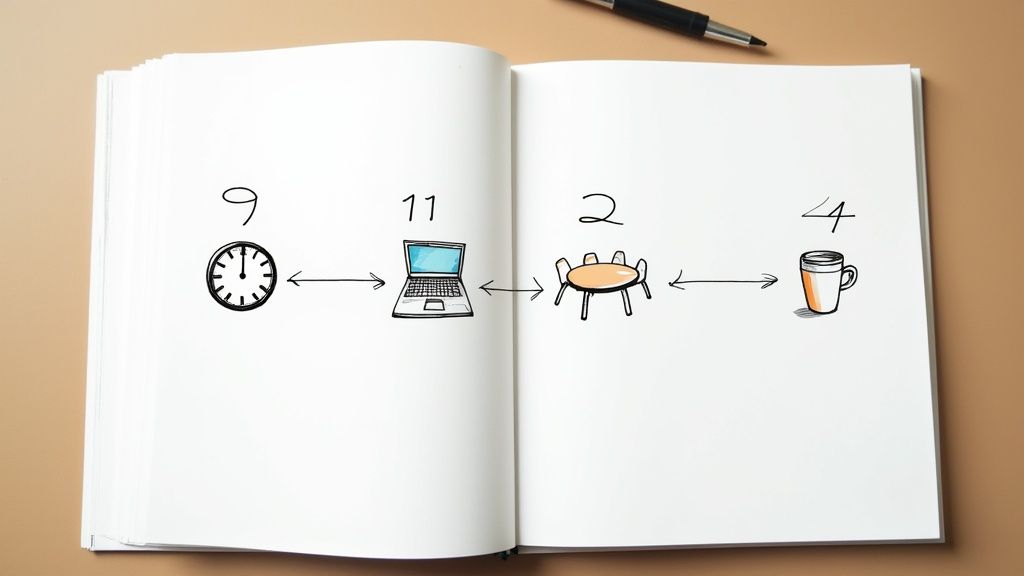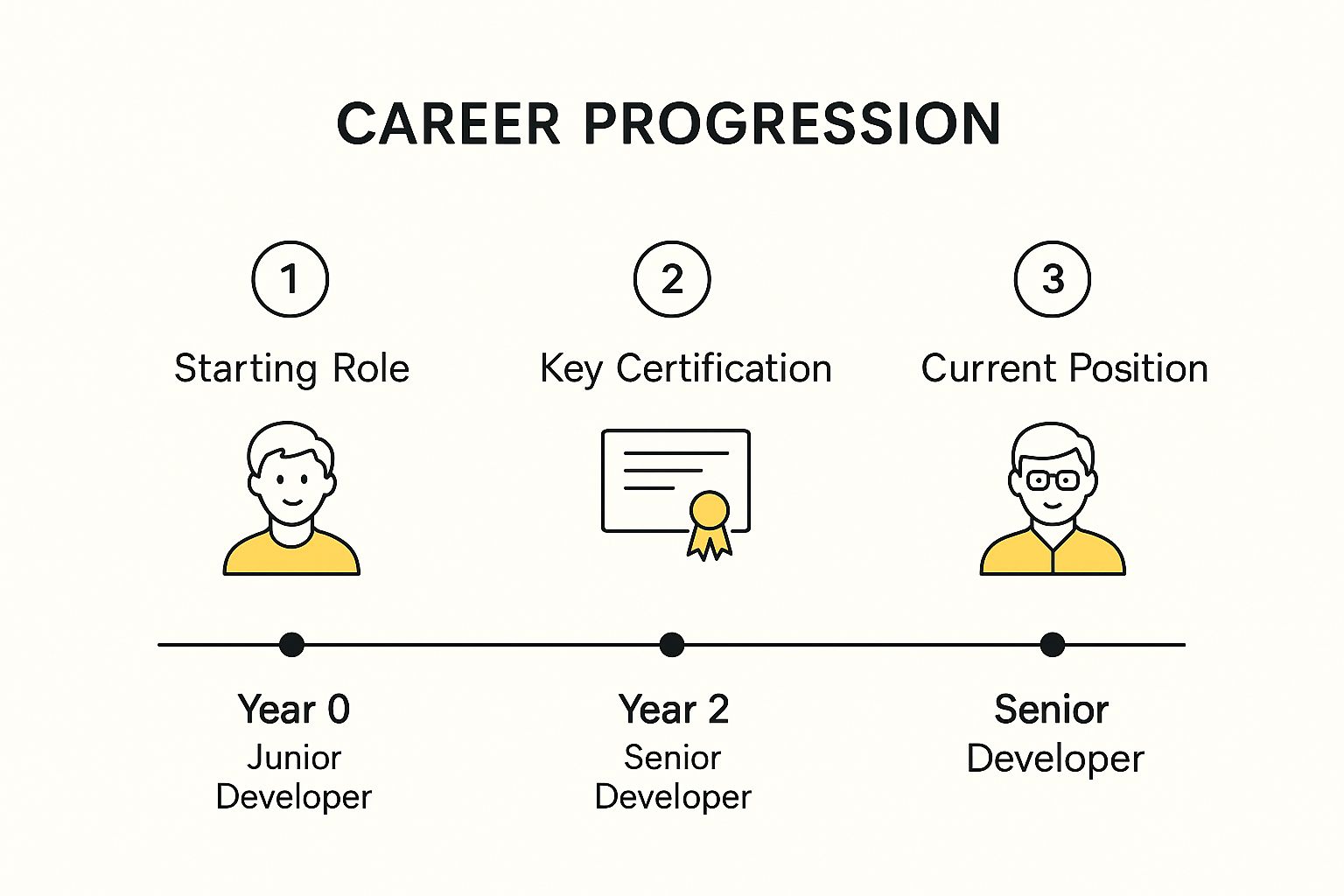8 Employee Testimonial Examples to Inspire Your Team

In a competitive talent market, authentic voices matter far more than polished corporate messages. Employee testimonials have become one of the most powerful tools for attracting top candidates, offering a genuine glimpse into your company culture, values, and growth opportunities. They transform abstract employer branding concepts into relatable, human stories that resonate with potential hires.
So, what separates a generic quote from a compelling endorsement? It comes down to strategy and authenticity. A truly effective testimonial doesn't just say your company is a great place to work; it shows why through specific, credible experiences. This guide is designed to move beyond theory and provide you with a practical toolkit. We will break down seven diverse employee testimonial examples, analysing the specific tactics that make them successful and providing actionable takeaways you can immediately apply.
We'll explore a range of formats, from impactful video narratives and detailed 'day-in-the-life' written accounts to testimonials focused on career growth and work-life balance. By the end, you'll have a clear framework for capturing and sharing your team's stories, helping you build a recruitment strategy grounded in trust. You can even simplify the collection process with platforms like GoodKudos, designed to gather authentic feedback effortlessly. Let's dive in.
1. Video Testimonial with Personal Story
The video testimonial featuring a personal story is arguably the most powerful format in our list of employee testimonial examples. It moves beyond generic praise to tell a compelling narrative about an individual's journey, growth, and connection to the company culture. This format leverages the authenticity of video to build an emotional connection with potential candidates, showing them what it’s really like to work for your organisation.
Major tech companies like Google, with their 'Life at Google' series, and Salesforce, with their 'Trailblazer' stories, pioneered this approach. They realised that a genuine story from a current employee is far more persuasive than a polished corporate overview. These videos showcase real people in their work environments, discussing specific projects, challenges they've overcome, and the support they received along the way.
Why This Format Works
- Authenticity and Trust: Video allows viewers to see body language and hear the tone of voice, which builds trust far more effectively than text. A genuine, unscripted story feels credible and relatable.
- Emotional Connection: Personal narratives about career progression or finding a supportive community resonate on an emotional level. Candidates can see themselves in the employee's journey.
- Show, Don't Tell: Instead of simply stating your company has a "great culture", this format shows it through the experiences of your team. This provides tangible proof of your employer value proposition.
Actionable Takeaways
To create a compelling video testimonial, focus on capturing an authentic narrative.
- Provide Talking Points, Not a Script: Give your employee a list of questions or themes to consider, such as "Describe a project you're proud of" or "How has the company supported your growth?". This encourages natural, heartfelt responses rather than a robotic delivery.
- Keep It Concise and Engaging: Aim for a final video length of 90 seconds to two minutes. This is long enough to tell a meaningful story but short enough to retain viewer attention on platforms like LinkedIn or your careers page.
- Prioritise Accessibility: Always include captions. This not only makes your content accessible to individuals with hearing impairments but also caters to the many users who watch videos with the sound off.
Crafting these stories can seem daunting, but platforms like GoodKudos streamline the process of collecting and showcasing video testimonials, making it easier than ever to bring your team's authentic experiences to the forefront. Start collecting powerful video testimonials today at Good Kudos.
2. Day-in-the-Life Written Testimonial
The day-in-the-life written testimonial offers a transparent, ground-level view of a specific role within your company. It goes beyond broad statements about culture by walking potential candidates through an employee's typical day, from their morning coffee routine to collaborating on key projects and signing off. This format demystifies a role and provides a realistic preview of the daily responsibilities and interactions, making it an incredibly valuable asset on any careers page.
Companies known for their strong remote work cultures, like Atlassian with its 'A Day in the Life' blog series and Buffer with its transparent employee stories, have perfected this approach. They understand that top candidates want to know the "how" and "what" of a job, not just the "why". These written accounts detail specific tasks, team meetings, and the tools used, giving a tangible feel for the position and the company's operational rhythm.

Why This Format Works
- Manages Expectations: It gives candidates a realistic job preview, which helps in attracting applicants who are a genuine fit for the role's day-to-day demands, reducing early turnover.
- Builds Relatability: A detailed, personal account feels more authentic and relatable than a formal job description. It allows candidates to picture themselves in the role.
- Highlights Company Culture in Action: This format demonstrates your culture through daily interactions, collaboration methods, and work-life balance instead of just listing values.
Actionable Takeaways
To create an effective day-in-the-life testimonial, focus on detail and an authentic voice.
- Use Time Stamps for Structure: Organise the post with time stamps (e.g., "9:00 AM: Team Stand-up," "1:00 PM: Lunch and Learn"). This creates a clear, easy-to-follow narrative of the employee's day.
- Mix the Mundane with the Exciting: A realistic day includes both routine tasks and exciting project work. Being honest about the full spectrum of responsibilities builds credibility and trust.
- Incorporate Photos and a Conversational Tone: Add photos of the employee's workspace, team meetings, or even their lunch break to add visual interest. Encourage a conversational, first-person writing style over corporate jargon.
Gathering and formatting these detailed stories can be time-consuming, but tools like GoodKudos can help you easily collect written testimonials from your team and present them professionally on your careers site. Visit Good Kudos to learn how.
3. Before-and-After Career Growth Testimonial
The before-and-after career growth testimonial is a powerful narrative format that showcases tangible professional development within your organisation. It contrasts an employee's skills and position when they first joined with their current, more advanced role. This format powerfully demonstrates your company's commitment to investing in its people through training, mentorship, and clear pathways for internal mobility.
Consulting firms like Deloitte and Accenture often feature stories of consultants who have progressed to partner level. Similarly, Amazon highlights its 'Career Choice' programme with testimonials from warehouse staff who have transitioned into high-skilled technical roles. These examples provide compelling evidence of a culture that nurtures talent and rewards ambition, making them excellent employee testimonial examples for attracting career-driven candidates.
This infographic illustrates a typical career progression timeline that can be highlighted in this testimonial format.

This visualisation effectively condenses a multi-year journey into clear, aspirational milestones, proving the company's role as a catalyst for growth.
Why This Format Works
- Concrete Proof of Opportunity: This format moves beyond promises of "growth opportunities" and provides tangible proof. It shows a clear return on investment for an employee's dedication.
- Highly Aspirational: Potential candidates can see a clear, achievable career path. This appeals directly to ambitious individuals seeking long-term roles, not just a job.
- Highlights Company Investment: It showcases specific training programmes, mentorship, and support systems, positioning your company as one that actively develops its talent.
Actionable Takeaways
To create an impactful before-and-after story, focus on illustrating the journey.
- Use Visual Contrasts: Feature side-by-side photos or video clips of the employee from their early days versus their current role. This visual storytelling is instantly compelling and easy to digest.
- Quantify the Growth: Include specific metrics like years with the company, the number of promotions, or new skills acquired. Mentioning specific training programmes or certifications that facilitated this growth adds credibility.
- Showcase Diverse Pathways: Don't just focus on vertical promotions. Highlight lateral moves into new departments or skill transformations, showing that growth can take many forms within your organisation.
Platforms like GoodKudos can help you capture these progression stories, organising text and video testimonials that clearly demonstrate the career-defining journeys available at your company. Showcase your team's growth by getting started at Good Kudos.
4. Work-Life Balance Testimonial
In a world where burnout is a growing concern, the work-life balance testimonial has become a crucial asset in an organisation’s recruitment strategy. This format directly addresses a top priority for modern job seekers by showcasing how a company actively supports its employees' lives outside of work. It moves beyond vague promises of "flexibility" to provide concrete proof of a culture that values wellbeing, personal time, and healthy boundaries.
Companies renowned for their progressive cultures, like Patagonia and Salesforce, have long used these testimonials to great effect. Patagonia highlights stories of employees taking "surf breaks," while Salesforce's "Ohana" culture testimonials often centre on family-first values and how the company supports working parents. These narratives are powerful because they demonstrate that achieving professional success doesn't require sacrificing personal fulfilment.

Why This Format Works
- Addresses a Key Candidate Concern: Work-life balance is no longer a perk; it's an expectation. This testimonial type speaks directly to this need, attracting talent who are seeking sustainable, long-term careers.
- Builds a Culture of Trust: By openly discussing policies like flexible hours, remote work, or generous parental leave, you demonstrate transparency and show that you trust your employees to manage their time effectively.
- Humanises the Organisation: Stories about attending a child's school play or pursuing a personal passion show that the company sees its team as whole people, not just workers. This fosters a stronger, more human connection with potential applicants.
Actionable Takeaways
To create an effective work-life balance testimonial, focus on tangible examples and genuine experiences.
- Be Specific About Policies: Instead of a general statement, have employees share how a specific policy helped them. For example, "Thanks to our flexible start times, I can drop my kids at school without rushing."
- Show, Don't Just Tell: If appropriate, use visuals of employees enjoying their time outside of work. This could be a photo from a family holiday funded by a bonus or a short clip of them engaging in a hobby made possible by a flexible schedule.
- Feature Diverse Life Stages: Showcase stories from a range of employees, including working parents, caregivers, students, or individuals pursuing significant personal interests. This broadens the appeal and shows that your support for balance is inclusive.
Highlighting these positive experiences is essential, and tools like GoodKudos can help you easily collect and share these powerful stories, reinforcing your commitment to employee wellbeing. Start sharing your culture of balance at Good Kudos.
5. Team Culture and Belonging Testimonial
While career growth and compensation are crucial, a strong sense of community and belonging is often the glue that retains top talent. This type of employee testimonial example focuses directly on the social fabric of your organisation: the team dynamics, inclusive culture, and supportive environment that make employees feel connected and valued beyond their job descriptions.
Companies renowned for their culture, like Airbnb with its 'Belong Anywhere' ethos and Netflix with its unique approach to freedom and responsibility, have leveraged these stories for years. They showcase how team members collaborate, how employee resource groups (ERGs) create safe spaces, and how an inclusive atmosphere allows individuals to bring their authentic selves to work. These testimonials are less about individual achievement and more about the collective experience.
Why This Format Works
- Highlights Key Differentiators: In a competitive market, a positive and inclusive culture can be your strongest unique selling proposition. These testimonials provide concrete proof of that culture.
- Appeals to Diverse Talent: Candidates, particularly from underrepresented groups, actively seek workplaces where they will be respected and included. Showcasing belonging is a powerful magnet for diverse talent.
- Boosts Authenticity: Discussing team relationships and cultural nuances feels genuine and less corporate. It answers the candidate's question: "Will I fit in and be happy here?"
Actionable Takeaways
To effectively capture your company's culture, focus on specific, relatable experiences.
- Spotlight Employee Resource Groups (ERGs): Feature members of your ERGs or affinity networks. Ask them to share how these groups have impacted their experience, fostered a sense of community, and contributed to their professional lives.
- Use Anecdotes, Not Adjectives: Instead of saying you have a "collaborative culture," ask an employee to describe a time their team rallied together to solve a difficult problem. Specific stories are far more memorable and believable.
- Show, Don't Just Tell: Complement the testimonial with B-roll footage or photos of team-building events, collaborative work sessions, or casual office interactions. Visual evidence of a vibrant culture reinforces the spoken message.
Capturing these nuanced stories of connection is vital, and tools like GoodKudos can help you easily collect and share these powerful testimonials, making your company culture tangible to prospective hires. Build your culture showcase at Good Kudos today.
6. Problem-Solving and Impact Testimonial
The Problem-Solving and Impact testimonial shifts the focus from general culture to tangible achievements. This format highlights an employee's journey in tackling a specific business challenge, detailing their innovative solution and its measurable impact. It’s a powerful way to demonstrate the meaningful work and autonomy your team members experience, proving that their contributions truly matter.
This approach has been perfected by innovation-led companies like Tesla and SpaceX. Their testimonials often feature engineers describing how they solved complex manufacturing or rocketry problems, showcasing not just the company's ambitious goals but the individual's critical role in achieving them. This style of employee testimonial example is ideal for attracting top-tier talent who are motivated by making a real difference.
Why This Format Works
- Demonstrates Tangible Impact: It moves beyond abstract claims about "meaningful work" and provides concrete proof of how employees contribute to the company's success.
- Appeals to High-Achievers: Ambitious candidates are drawn to roles where they can solve complex problems and see the results of their efforts. This format speaks directly to that desire.
- Highlights Autonomy and Trust: Showcasing an employee who was empowered to devise and implement a solution sends a strong signal that your organisation trusts its people and values their expertise.
Actionable Takeaways
To build a compelling problem-solving testimonial, structure the narrative around a clear beginning, middle, and end.
- Use the STAR Method: Frame the story using the Situation, Task, Action, and Result (STAR) framework. This provides a clear, logical, and persuasive narrative that is easy for candidates to follow.
- Include Specific Metrics: Quantify the impact wherever possible. Did their solution increase efficiency by 20%? Did it improve customer satisfaction scores? Numbers add credibility and weight to the story.
- Connect to the Bigger Picture: Explain how the employee's individual contribution helped advance the company's overall mission. This reinforces the idea that every role is vital and contributes to a larger purpose.
Organising and sharing these detailed stories can be challenging, but tools like GoodKudos provide a centralised platform to collect, manage, and showcase these powerful impact narratives, ensuring potential candidates see the incredible work your team is doing. Start showcasing your team's impact by visiting Good Kudos.
7. New Hire Onboarding Experience Testimonial
The new hire testimonial focuses on the critical first few months of employment, offering a transparent look at the recruitment, onboarding, and initial integration process. This type of testimonial is invaluable for addressing the anxieties of potential candidates, as it provides a firsthand account of the support and structure they can expect when joining your team. It shifts the focus from long-term career paths to the immediate experience of becoming part of the company.
Companies known for robust graduate and training programmes, like Deloitte and Ernst & Young, frequently use this approach to attract top talent from universities. They showcase new hires reflecting on their first year, discussing the learning curve, mentorship, and the transition from education to a professional environment. Similarly, Apple's testimonials from new retail staff often highlight the comprehensiveness of their initial training, reassuring candidates that they will be fully equipped for success.
Why This Format Works
- Addresses Candidate Anxiety: Starting a new job is daunting. Hearing from a recent hire about a positive and well-structured onboarding process directly calms common fears and builds confidence in the organisation.
- Sets Clear Expectations: This format gives a realistic preview of the first 90 days, from training modules to meeting the team and achieving early wins. This transparency helps attract candidates who are a good fit for your process.
- Demonstrates Investment in People: A testimonial dedicated to the onboarding experience proves that your company invests in new employees from day one, fostering a sense of value and belonging before they even apply.
Actionable Takeaways
To capture an authentic new hire story, time your request carefully and ask specific questions.
- Capture Feedback at Key Milestones: Don't wait a year. Ask for feedback at the 30, 60, and 90-day marks to capture fresh, detailed perspectives on the onboarding journey.
- Ask About "Expectation vs. Reality": This question encourages honest reflection. Ask what surprised them, what was better than expected, and how the company helped them navigate any challenges.
- Highlight Specific Support: Prompt new hires to mention specific people, tools, or training sessions that were particularly helpful. Naming a helpful manager or a great mentor makes the story more personal and credible.
Showcasing a smooth and supportive start is a powerful recruitment tool. Platforms like GoodKudos can help you systematically collect these crucial early-stage employee testimonial examples, ensuring you have a steady stream of content that speaks directly to your future hires. See how it works at Good Kudos.
7 Employee Testimonial Types Comparison
| Testimonial Type | Implementation Complexity 🔄 | Resource Requirements ⚡ | Expected Outcomes 📊 | Ideal Use Cases 💡 | Key Advantages ⭐ |
|---|---|---|---|---|---|
| Video Testimonial with Personal Story | High: filming, editing, multiple takes | High: video equipment, editing skills | High engagement, emotional connection, higher retention | Career pages, social media campaigns, recruitment ads | Builds trust through authenticity, visual storytelling |
| Day-in-the-Life Written Testimonial | Low: writing with structure and detail | Low: writing skills, minimal visuals | Realistic job preview, SEO benefits | Company blogs, career pages, recruitment emails | Easy to produce, helps cultural fit, showcases daily work |
| Before-and-After Career Growth Testimonial | Medium: requires data, visuals, balanced narrative | Medium: photos, metrics collection | Demonstrates career progression, motivates candidates | Graduate recruitment, internal L&D promotions | Concrete evidence of development, builds credibility |
| Work-Life Balance Testimonial | Medium: authentic stories, policy details | Medium: diverse employee input, photos | Attracts flexibility-focused candidates | Attracting parents, remote workers, flexibility seekers | Highlights progressive values, relevant to modern workforce |
| Team Culture and Belonging Testimonial | Medium: varied stories, inclusive focus | Medium: capturing diverse voices, photos | Showcases culture, diversity, psychological safety | Diversity recruitment, campus recruiting, branding | Humanizes brand, authentic D&I showcase |
| Problem-Solving and Impact Testimonial | High: detailed project focus, metrics, clarity | High: technical input, outcome data | Demonstrates meaningful work, impact, autonomy | Technical recruitment, conferences, case studies | Highlights expertise, concrete impact examples |
| New Hire Onboarding Experience Testimonial | Low-Medium: recent hires' perspective, honest input | Low-Medium: interviews/writing with new hires | Reduces candidate anxiety, shows onboarding support | Job offer communications, onboarding promotion, campus | Builds confidence, fresh cultural insights |
Turn Your Team's Stories into Your Greatest Asset
We have explored a diverse range of powerful employee testimonial examples, from deeply personal video narratives to detailed day-in-the-life blog posts. The common thread connecting them all is a commitment to authenticity and strategic storytelling. Effective testimonials are not generic endorsements; they are specific, evidence-based accounts of growth, culture, impact, and support within an organisation.
The most compelling testimonials move beyond surface-level praise. They illustrate a journey, whether it's the professional development in a career-growth story, the sense of belonging captured in a culture testimonial, or the tangible impact an employee has on a project. By showcasing these real experiences, you provide potential candidates with an honest, compelling glimpse into what it’s truly like to work for you. This builds a foundation of trust long before the first interview.
Key Takeaways for Your Recruitment Strategy
To transform your team’s voice into a recruitment powerhouse, remember these core principles:
- Specificity Over Generality: Instead of "it's a great place to work," encourage stories that show why. Was it a specific supportive manager, a challenging project, or a flexible working policy that made the difference?
- Embrace Diverse Formats: A single format won’t resonate with everyone. Combining video, written stories, and even simple quotes allows you to connect with different audiences across various platforms, from your careers page to your social media channels.
- Authenticity is Non-Negotiable: Candidates can easily spot an overly-scripted or heavily-edited message. The goal is to capture your employees' genuine personalities and perspectives, creating a believable and relatable employer brand.
- Focus on the "Before and After": Highlight transformation. Showcasing how an employee has grown, learned new skills, or achieved a better work-life balance provides tangible proof of the value your organisation offers.
Your Actionable Next Steps
Armed with these insights, it's time to put theory into practice. Begin by identifying employees who have compelling stories that align with your key recruitment messages. Think about the various experiences covered in our employee testimonial examples: the new hire who had a fantastic onboarding, the long-term employee who has seen significant career progression, or the team member who feels a deep connection to your company culture.
Approach them with a clear idea of the story you want to tell but give them the freedom to share it in their own words. The most powerful recruitment marketing tool you possess is the collection of authentic, positive experiences your current team members have every day. By learning to capture and share these stories effectively, you turn your greatest asset, your people, into your most persuasive advocates.
Ready to effortlessly collect and showcase compelling stories from your own team? Good Kudos provides a simple, powerful platform for gathering authentic video and written testimonials. You can create a branded 'Kudos Wall' in minutes and start sharing your team’s experiences to attract top talent. Visit Good Kudos to see how easy it is to let your team become your most powerful voice in recruitment.
Article created using Outrank
